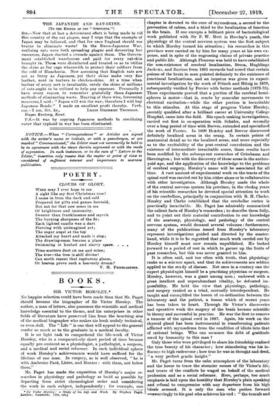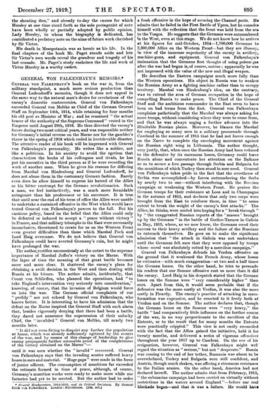BOOKS.
SIR VICTOR HORSLEY.*
No happier selection could have been made than that Mr. Paget should become the biographer of Sir Victor Horsley. The author, a man of letters, also possesses the scientific and medical knowledge essential to the theme, and his enterprises in other fields of literature have preserved him from the besetting sins of the medical biographer who makes his book unduly technical, or even dulL The " Life " is one that will appeal to the general reader as much as to the graduate in a medical faculty.
It is no light task to comprehend the life-work of Victor Horsley, who in a comparatively short period of time became equally pre-eminent as a physiologist, a pathologist, a surgeon, and a medical and social reformer. In each individual: sphere of work Horsley's achievements would have sufficed for the lifetime of one man. In surgery, as is well observed, " he is with Ambroise Pare, Lister, and Hunter : with them, not below them."
Mr. Paget has made the exposition of Horsley's major re- searches in physiology and pathology as lucid as possible by departing from strict chronological order and considering the work in each subject, independently ; for example, one • Sir Victor Horsley : a Study of his Life end Work. By Stephen Paget. London: Constable. I21s. net.): chapter is devoted to the cure of myxoedema, a second to the prevention of rabies, and a third to the localization of function in the brain. If one excepts a brilliant piece of bacteriological work published with Sir F. W. Mott in Horsley's youth, the physiology of the central nervous system was the first subject to which Horsley turned his attention ; his researches in this province were carried on by him for many years at his own ex- pense, and in spite of the engrossing claims of private practice and public life. Although Flourens was held to have-established the non-existence of cerebral localization, Broca, Hughlings Jack: oa, and Bastian from 1861 onwards had noted that certain lesions of the brain in man pointed definitely to the existence of functional localizations, and an impetus was given to experi- mental investigation by the work of Fritsch and Hitzig in 1870, subsequently verified by Ferrier with better methods (1873-75). These experiments proved that a portion of the cerebral hemi- spheres is motor—that is, reacts by muscular movements to electrical excitation—while the other portion is inexcitable to this stimulus. At this stage of progress Victor frorsley, recently qualified after a brilliant career at University College Hospital, came into the field. His epoch-making investigations, carried out first in co-operation with Schafer, and secondly over a long period of time with Beevor, extended and specialized the work of Ferrier. In 1890 Horsley and Beevor discovered definitely localized areas in the orang. In certain points of anatomical detail as to the localized areas, and more especially as to the excitability of the post-central convolution and the existence of intermediate inexcitable zones, these results have been modified by the subsequ ent researches of Griinbaum and Sherrington ; but with the discovery of these areas in the anthro- poid ape, and the application of the knowledge to the problems of cerebral surgery, Horsley's name will be associated for all time. A vast amount of experimental work on the tracts of the spinal cord was carried out by him either alone or in collaboration with other investigators. Although Horsley made the whole of the central nervous system his province, in the closing years of his scientific researches he devoted special attention to work on the cerebellum, principally in conjunction with B,. H. Clarke. Horsley and Clarke established that the cerebellar cortex is practically inexcitable. Mr. Paget has admirably summarized the salient facts of Horsley's researches ; to describe them fully, and to point out their material contribution to our knowledge of the anatomy, physiology, and pathology of the central nervous system, would demand several volumes : furthermore, many of the publications issued from Horsley's laboratory represent investigations guided and directed by the master- hand, while it is to be regretted that much work carried out by Horsley himself must now remain unpublished. He looked forward to a period of rest in which to gamer up the fruits of past researches, but this was never granted to him.
It is often said, and too often with truth, that physiology ranks as a science apart, and that its achievements are seldom applied to the study of disease. Not once in a century can the expert physiologist himself be a practising physician or surgeon. Horsley, however, was a giant among men ; endowed with a great intellect and superabundant vitality, he defeated im- possibility. He held the view that physiology, pathology, and surgery ranked as a triad, mutually interdependent. He taught and exemplified the lesson of co-Ordination between the laboratory and the patient, a lesson which of recent years has been taken to heart. Through Sir Victor's discoveries and operative work the surgery of the brain became scientific in theory and successful in practice. He was the first to remove a tumour of the spinal cord in 1887. Again, his work on the thyroid gland has been instrumental in transforming patients afflicted with myxoedema from the condition of idiots into that of rational beings. Who can measure the debt of gratitude owed by humanity to this man ?
Only those who were privileged to share his friendship realized the true beauty of his character ; how stimulating was his in- fluence to high endeavour ; how true he was in thought and deed, " a very perfect gentle knight."
Mr. Paget turns from the calm atmosphere of the laboratory and the home to trace the stormier scenes of Sir Victor's life, and treats of the conflicts he waged on behalf of the medical profession and as a social reformer. Here, perhaps, too much emphasis is laid upon the hostility that Horsley's plain speaking and refusal to compromise with any departure from his high ideals aroused. It is only the man who pushes forward 'unswervingly to his goal who achieves his end : " the tumult and the shouting dies," and already to-day the causes for which Horsley at one time stood forth as the sole protagonist of note have been wholly or partially adopted by public opinion. Lady Horsley, to whom the biography is dedicated, has contributed a prefatory note on the aims of future work cherished by Sir Victor.
His death in Mesopotamia was as heroic as his life. In the final chapters of the book Mr. Paget stands aside and lets Sir Victor's own words reveal the grandeur and tragedy of his Iast crusade. Mr. Paget's study enshrines the life and work of Victor Horsley in a worthy casket.



























 Previous page
Previous page